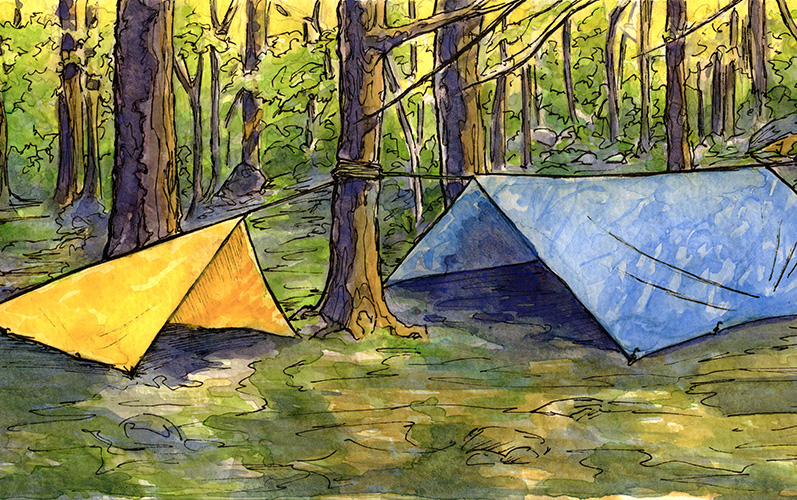

The diamond (left) and A-frame (right) are two easy-to-pitch emergency tarp shelters. Illustration: Rebbecca M. Fullerton
In the event of a backcountry emergency—such as a debilitating injury, unexpected night out, or severe weather event—a simple lightweight tarp can provide crucial protection from the elements, if you know how to use it.
Covering the Basics
Tarps come in a variety of dimensions. An 8-by-10 foot tarp can provide full coverage for up to two people; a 6-by-8 foot version provides adequate protection for only one. Grommets or tie-out loops on the tarp’s corners and along its edges are a common—and essential—feature for an easy and taut pitch.
In addition to the tarp, you’ll need about 50 feet of lightweight cord. Adding four to six ultralight stakes makes setup easier (a set of four titanium stakes weighs as little as 1 ounce), although you can use rocks or other available materials, if necessary.
Tarps are available in different materials, including coated nylon, silnylon, and Cuben Fiber, all of which work well for constructing a emergency tarp shelter. These lightweight materials make it easy to pack a tarp for a group hike. Note that crinkly Mylar space blankets—a common item in survival kits—are easily torn and all but useless for setting up a shelter.
Survival Pitch #1: The Diamond
The diamond is one of the simplest and fastest shelters you can create. To pitch it, locate a reasonably strong tree with approximately 8 feet of open ground around it. Face the tree with the wind against your back and tie a loop of cord around the trunk at chest to head height. Preparing a large loop with 15 to 20 feet of cord in advance allows you to hitch it to the tree in seconds.
Now attach one corner of the tarp to the cord on the tree. You can do this in a variety of ways. If you’ve hitched a loop of cord to the tree, simply feed the free end through the corner grommet or tie-out point, insert a short but strong stick through the loop on the other side, and pull the stick taut against the tarp. This creates an easy and secure attachment that’s quick to remove later. Alternatively, if you’ve tied the cord to the tree and have a loose end, you can use the same stick technique by tying a loop with a bowline, a figure-eight on a bight, or another preferred knot. Or you can simply tie the loose end of the cord directly to the grommet or tie-out point.
Pull the tarp tight and stake down the corner opposite from the tree. Next stake down the other two corners to create a taut pitch, and voila, your shelter is complete.
Survival Pitch #2: The A-Frame
You can pitch this classic tent shape with two trees or two trekking poles. The A-frame takes more time and effort than the diamond configuration but provides more consistent headroom.
Locate two trees 10 to 15 feet apart with sufficiently open ground between them for the “floor” of your shelter. Tie a length of cord between them at approximately waist height to create the ridgeline for your shelter. You’ll need to adjust the tension, so secure at least one end with a knot that allows you to tighten or loosen it, such as a taut-line hitch.
Drape the tarp over the cord, centering the tarp lengthwise. For the fastest and most stable construction, stake the four corners directly into the ground and tension the ridgeline cord as needed to provide sufficient headroom. In less severe weather, or if you have more time, you can secure guylines to the corners and edges of the tarp, which lets you pitch the tarp higher, gaining more headroom and better ventilation.
To pitch an A-frame with trekking poles, adjust the poles so they’re waist- to stomach-height. Next, plant one pole in the ground and position the tarp so one of its shorter sides is centered over the trekking pole handle. Now take a section of cord 8 to 10 feet long. Use one end to attach the tarp to the pole. One method is to wrap the tarp over the top of the handle and secure it firmly with a slip knot; another is to plant the pole handle on the ground and insert the tip through the tie-out loop (grommets are usually too small for this method). Now tie a loop at the other end of the cord and stake it down. Repeat on the opposite side then stake the four corners to create a taut pitch.